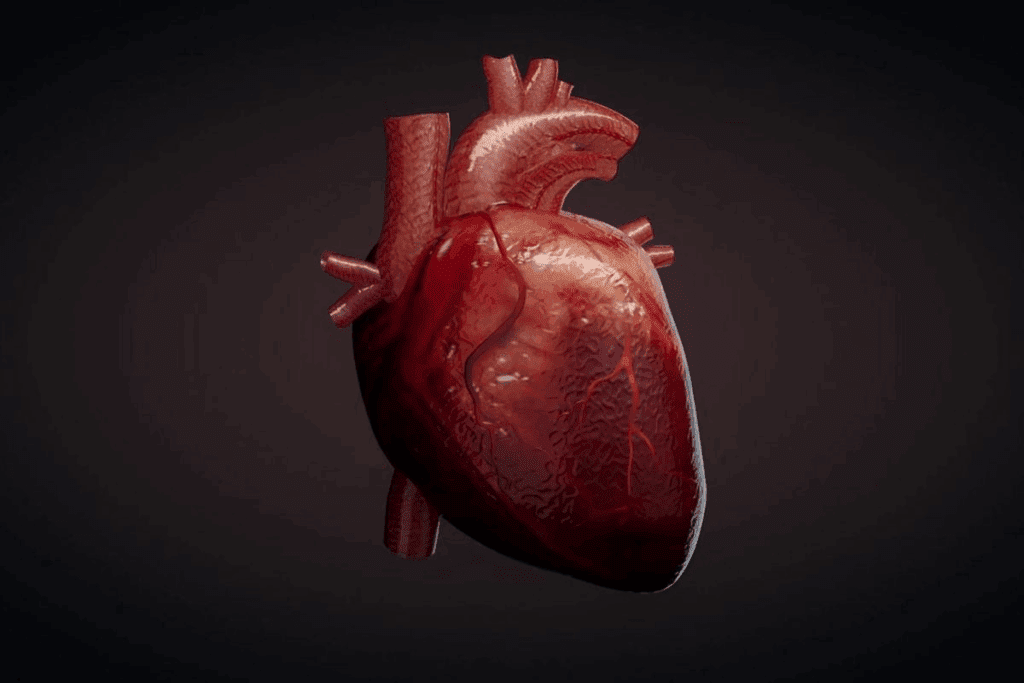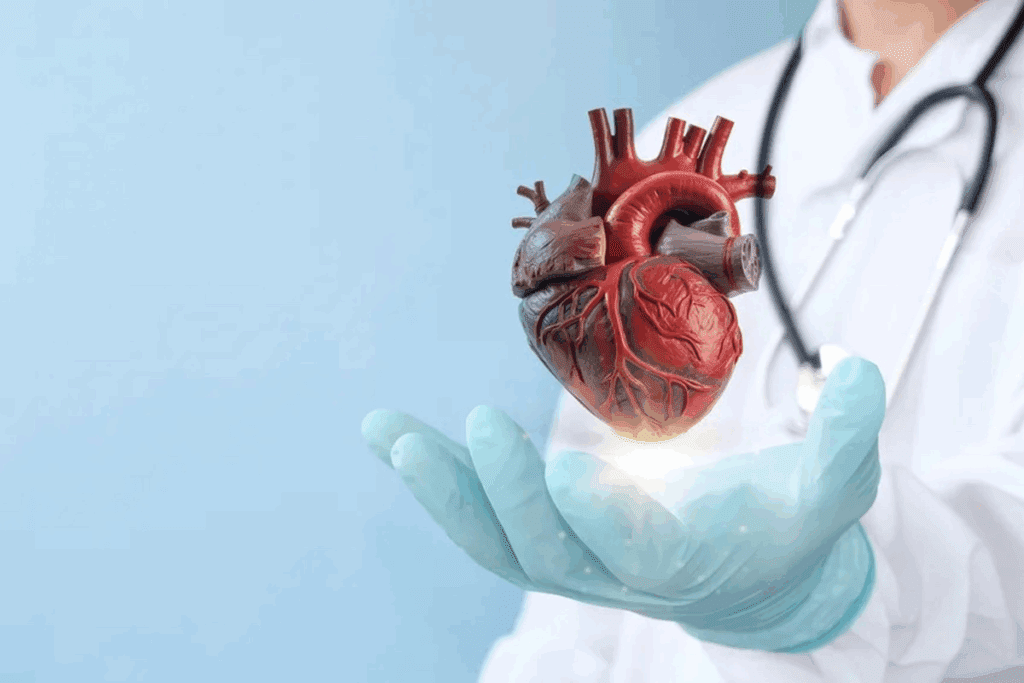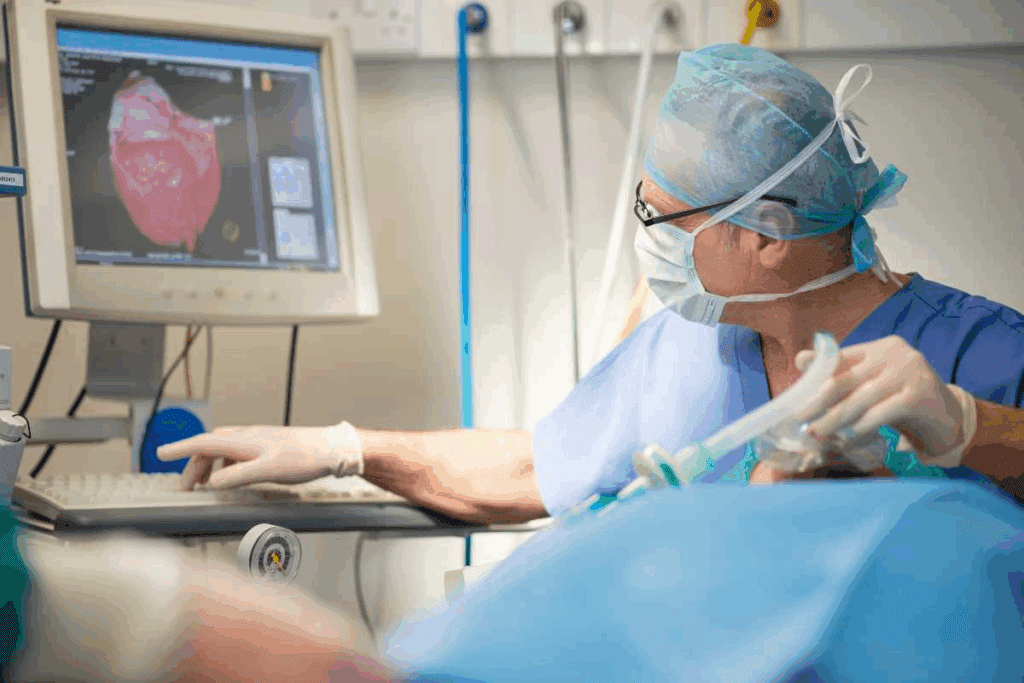Last Updated on October 31, 2025 by Batuhan Temel

Discover how the aortic valve works, its cusps, and anatomy with labeled diagrams and essential facts.
At the heart of our cardiovascular system lies a key component. It ensures blood flows in one direction. This valve is between the left ventricle and the aorta, playing a vital role in keeping our heart healthy.
The aortic valve has three cusps that work together. They prevent backflow, allowing blood to flow efficiently throughout the body. Its proper functioning is key for our cardiac health.

The aortic valve is key to the heart’s health. It makes sure blood flows right from the heart to the body. This stops blood from going back into the heart when it shouldn’t.
Having a healthy aortic valve is vital for the heart. Problems with it can cause serious heart issues. Knowing how the aortic valve works helps us understand its importance for heart health.
| Function | Description | Impact on Heart Health |
| Regulates Blood Flow | Ensures blood flows from the heart to the body | Critical for maintaining cardiac output |
| Prevents Backflow | Stops blood from flowing back into the heart during diastole | Essential for efficient heart function |
The aortic valve’s role in heart health is huge. It’s essential for the heart to work well. Any problems can cause serious health issues.
In conclusion, the aortic valve is a vital part of the heart. It plays a key role in keeping the heart healthy. Its proper function is necessary for blood to flow well throughout the body.

Exploring the aortic valve’s structure shows its key role in heart health. It’s a vital part of the heart, ensuring blood moves right from the heart to the body.
The aortic valve has important parts like the cusps, annulus, and sinuses of Valsalva. The cusps, or semilunar valves, are essential. They let blood flow forward and stop it from going back.
The valve’s tissue mix includes collagen, elastin, and more. This mix gives the valve the strength and flexibility it needs to work well.
| Component | Description | Function |
| Cusps | Semilunar valves that open and close to regulate blood flow | Allow blood to flow from the heart to the aorta while preventing backflow |
| Annulus | The ring-like structure that supports the cusps | Provides a stable base for the cusps to function |
| Sinuses of Valsalva | Dilations in the aortic wall behind the cusps | Facilitate the proper closure of the cusps and help regulate blood flow |
The aortic valve’s detailed structure highlights its role in heart health. Knowing about its anatomy and function is key for diagnosing and treating heart problems.
Understanding the cusps of the aortic valve is key to knowing how it works. The aortic valve has three cusps. Each cusp is important for blood to flow right from the heart to the body.
The right coronary cusp is one of the aortic valve’s three parts. It’s linked to the right coronary artery. This cusp is vital for blood to flow well from the heart to the aorta.
The left coronary cusp is also a key part of the aortic valve. It’s connected to the left coronary artery. This cusp works with the others to ensure blood flows smoothly and doesn’t go back into the heart.
The non-coronary cusp, or posterior cusp, is the third cusp. It doesn’t connect to coronary arteries like the other two. Yet, it’s just as important for the aortic valve’s function.
The right coronary cusp, left coronary cusp, and non-coronary cusp work together. They open and close in sync. This lets blood flow forward and keeps it from going back into the heart.
The aortic valve’s design is best seen in labeled diagrams and aortic valve pictures. These tools help us grasp the complex layout of the valve’s parts.
Anatomical views of the aortic valve are key for learning and medical diagnosis.
These can be illustrations, diagrams, or images from medical scans.
They show the valve’s details, like its cusps, sinuses, and nearby areas.
| Visual Representation | Key Features Highlighted |
| Labeled Diagrams | Cusps, sinuses, and surrounding structures |
| Aortic Valve Pictures | Detailed anatomy, possible issues |
| 3D Reconstructions | Layout, how it moves |
Healthcare experts use these visuals to diagnose and treat aortic valve problems.
Labeled diagrams and aortic valve pictures improve our grasp of this vital heart part.
The sinuses of Valsalva are key parts of the aortic valve complex. They help with coronary blood flow. Located between the aortic valve annulus and the sinotubular junction, they are essential in cardiac anatomy.
The sinuses of Valsalva are connected to the aortic valve cusps. There are three sinuses, each linked to a cusp: the right coronary, the left coronary, and the non-coronary sinus.
During diastole, the sinuses store blood for the coronary arteries. This is vital for coronary blood flow. It’s key for the heart’s health.
The connection between sinuses and cusps is complex. The cusps are attached to the aortic wall in a semilunar shape. The sinuses are the widened parts of the aorta, matching each cusp.
Knowing the sinuses of Valsalva and their connection to the aortic valve cusps is important. It helps in diagnosing and treating issues with the aortic valve and coronary arteries.
It’s important to understand how the aortic valve works. It plays a key role in keeping blood flowing from the heart to the rest of the body.
The aortic valve’s operation is complex. When the left ventricle contracts, it pushes blood into the aorta. This is because the pressure in the ventricle is higher than in the aorta.
When the left ventricle relaxes, the pressure drops. This causes the aortic valve to close. Closing the valve is important to stop blood from flowing back into the heart.
Key Factors Influencing Aortic Valve Function:
| Phase | Description | Pressure Gradient |
| Opening | The valve opens as left ventricular pressure exceeds aortic pressure | Positive |
| Closing | The valve closes as left ventricular pressure drops below aortic pressure | Negative |
The typical aortic valve has three cusps. But, variations like the bicuspid aortic valve pose unique challenges. These changes can affect the valve’s function and heart health.
A bicuspid aortic valve is a birth defect with only two cusps. It affects about 1-2% of people. It can cause problems like stenosis or regurgitation.
| Characteristics | Normal Tricuspid Valve | Bicuspid Aortic Valve |
| Number of Cusps | 3 | 2 |
| Prevalence | Normal anatomy | 1-2% of population |
| Common Complications | Less prone to complications if normal | Increased risk of stenosis, regurgitation |
It’s important to understand these variations for proper diagnosis and treatment. We will look into the effects of such changes further.
Imaging techniques are key in checking the aortic valve’s health. They help doctors see the valve’s shape and how it works. This is important for spotting any problems or diseases early.
Echocardiography is a non-invasive method that uses sound waves to see the heart. It includes the aortic valve. This tool helps doctors check the valve’s shape, how it moves, and blood flow.
It’s great because it’s safe, easy to get, and doesn’t cost much. But, the quality of the images can be affected by the patient’s body or lung issues.
CT and MRI scans give detailed views of the aortic valve and nearby areas. CT scans are good for seeing valve calcification and the aortic root. MRI scans are better for soft tissue details and how the valve works.
These scans are vital for planning surgeries or procedures like TAVR. They also help check on patients after these treatments.
| Imaging Technique | Key Features | Clinical Applications |
| Echocardiography | Non-invasive, uses ultrasound waves | Assess valve morphology and function, detect stenosis or regurgitation |
| CT Imaging | Detailed anatomical information, assesses calcification | Pre-procedural planning for TAVR, assess aortic root |
| MRI Imaging | Superior soft tissue characterization, functional assessment | Evaluate valve function, plan surgical interventions, monitor post-procedure |
Using these imaging methods helps us better understand the aortic valve. This knowledge leads to better care for our patients.
The aortic valve’s complex anatomy has big impacts on patient care. Knowing these impacts is key for right diagnosis and treatment plans.
| Anatomical Feature | Clinical Significance |
| Aortic Valve Cusps | Proper coaptation is key to stop regurgitation. |
| Sinuses of Valsalva | They help with coronary artery start and valve work. |
| Valve Leaflet Thickness | It affects how well the valve opens and closes. |
The aortic valve’s anatomy shapes how doctors diagnose. Imaging techniques like echocardiography, CT scans, and MRI help see the valve’s shape and how it works.
Aortic valve problems include stenosis and regurgitation. These issues can harm the valve and the heart. Knowing about them is key to good care.
Aortic stenosis happens when the valve opening gets smaller. This makes it hard for blood to flow out of the heart. Symptoms can be chest pain, fainting, and shortness of breath.
Stenosis can be caused by birth defects, valve calcification, or rheumatic fever. It’s important to catch it early to treat it well.
| Cause | Description | Impact |
| Congenital Heart Defects | Present at birth, affecting valve structure | Potential for early onset symptoms |
| Calcification | Calcium deposits on the valve | Narrowing of the valve opening |
| Rheumatic Fever | Complication of untreated strep throat | Potential for valve damage |
Aortic regurgitation happens when the valve doesn’t close right. This lets blood flow back into the heart. It can cause heart failure if not treated.
Regurgitation can be caused by valve damage, endocarditis, or a big aortic root. Symptoms include palpitations, shortness of breath, and fatigue.
It’s vital to know about aortic valve problems like stenosis and regurgitation. We’ve looked at their causes, symptoms, and treatments. Early diagnosis and proper care are very important.
We’ve looked into the aortic valve’s detailed anatomy and function. It’s a key part of the heart. The aortic valve is vital for keeping blood flowing right from the heart to the rest of the body.
Knowing how the aortic valve works is key to spotting and treating problems. Issues like aortic stenosis and regurgitation can harm the heart. So, it’s important to catch and fix these problems early.
Understanding the aortic valve’s role helps us see why regular heart checks are important. It also shows why living a heart-healthy lifestyle matters. This knowledge helps people take care of their heart health better.
A: The aortic valve is a key part of the heart. It’s between the left ventricle and the aorta. It makes sure blood flows only one way, stopping it from going back into the left ventricle when it’s not pumping.
A: The aortic valve has three cusps. These are the right coronary cusp, the left coronary cusp, and the non-coronary cusp. Each cusp is linked to specific parts of the heart.
A: The sinuses of Valsalva are important for the heart. They hold blood that feeds the coronary arteries when the heart is not pumping. This is key for the heart’s health.
A: Changes in the aortic valve, like a bicuspid valve, can cause big heart problems. They might need medical treatment to avoid serious issues.
A: Doctors use echocardiography, CT, and MRI to check the aortic valve. These tools help find and track problems, guiding treatment choices.
A: Issues with the aortic valve, like stenosis or regurgitation, can harm the heart. Knowing about these problems is key to keeping the heart healthy.
A: Knowing the aortic valve’s structure is vital for diagnosing and treating heart problems. It also helps us understand its role in keeping the heart working well.
A: The aortic valve is essential for the heart’s function. It ensures blood flows only one way, which is important for the heart’s efficiency.
A: The aortic valve opens when the left ventricle pumps blood into the aorta. It closes when the ventricle relaxes, stopping blood from flowing back.
A: The aortic valve is critical for heart health. It helps ensure blood flows correctly and prevents problems that can arise from its malfunction.
Subscribe to our e-newsletter to stay informed about the latest innovations in the world of health and exclusive offers!
WhatsApp us